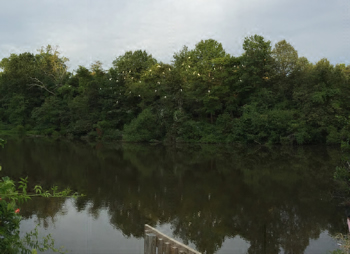
Recently a park patron took a picture of around 48 wading birds, mostly Great Egrets or Snowy Egrets, roosting around a pond in Hartshorne Woods Park, near the Navesink River. The birds swooped into the trees to rest, relax and to wait for the next low tide to forage. There are actually many of these waterside roosts all over Monmouth County. They provide an important and safe location for birds at night to congregate, to rest, stay warm, and find protection from predators. If you see birds roosting, please stay far away, as too many disturbances to a roosting site will cause birds never to return. Posted 8/12/2015

A lucky group of third graders got to see young flying squirrels during their class trip to the Manasquan Reservoir. Two species of flying squirrels are native to New Jersey, the Northern and Southern Flying squirrels. These nocturnal animals are common, but seldom seen. They are active at night, high in the tree canopy. Flying squirrels do not fly, but glide. A membrane that extends from their front to back legs allows them to glide from tree to tree. They steer as they glide by adjusting their legs. Flying squirrels nest in abandoned woodpecker holes in dead trees. Posted 6/9/2015
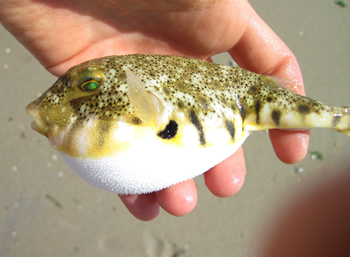
During a recent saltwater seining program near Sandy Hook Bay, Park System Naturalists found a blowfish or a Northern puffer fish in a seine net. Without a doubt, third graders visiting the park during a school field trip were thrilled to see the little fish as it puffed up about twice its size by inhaling air or water into a special organ near its stomach. Thanks to improving water quality in New York Harbor, blowfish are becoming more common sights. They can be found from spring through fall, leaving the harbor in the winter for deeper ocean waters. Posted 6/2/2015.
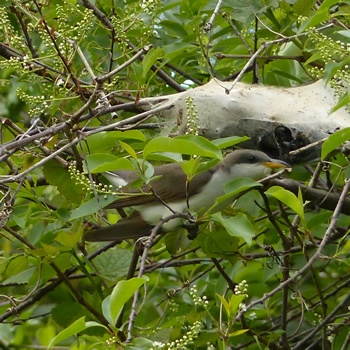
This is a very secretive bird and if were not for their loud and distinct call most would go unnoticed. It is a common breeder in Monmouth County and can be found in most of our parks during the summer months.
Yellow-billed cuckoos live in wooded habitat with dense cover, abandoned farmland, and dense thickets along streams and marshes. This is one of the few bird species that feeds on hairy caterpillars. Cuckoos have been known to devour 100 tent caterpillars in one sitting. They will also feed on insects, frogs and lizards. The cuckoo will lay its eggs several days apart thus the ages of the chicks can vary as much as five days. During times of scarce food, the male cuckoo may remove the youngest bird from the nest. The nesting cycle is only 17 days from hatching to fledging. Both parents take part in the brooding and switch often during the day. The male, however, will stay with the nest all night. Once in awhile, yellow-billed cuckoos will lay their eggs in nests of other birds such as robins, catbirds and wood thrushes. Posted 05/19/15
Nodding trillium in Thompson Park, Lincroft
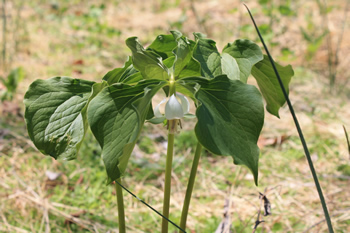
Photo by Jamie Evans
Park staff recently found a plant called nodding trillium, or trillium cernuum, at Thompson Park, Lincroft. This is the first time staff has identified this species in the parks, although other trillium species have been reported from some of our western Monmouth parks. Trillium are not studied particularly well in the state, but many are increasingly rare throughout their ranges due to habitat destruction and deer herbivory. The seeds are typically dispersed by ants, which carry the fleshy coated seed away from the flower, consuming the fleshy parts and depositing the seed. It’s probable that this plant has been here a long time – and just overlooked when not in bloom, as its leaves do resemble non-flowering Jack-in-the-pulpit.
(posted 5/19/2015)
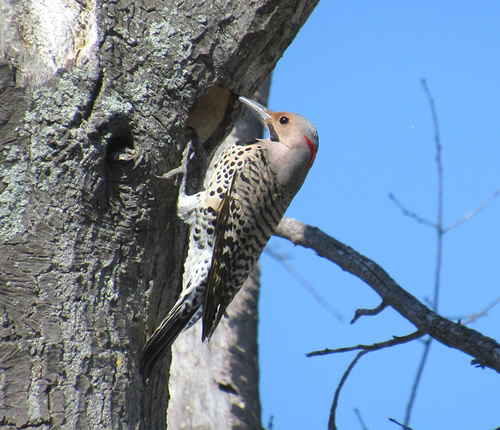
Recently, a Park System Naturalist noticed a newly arrived male Northern “yellow-shafted” flicker woodpecker making a summer home in a dead tree at the Bayshore Waterfront Park, not far from the beach. The bird was busy carving out a 3-inch hole approximately 15 to 20 feet off the ground. The female was in close proximity as well, foraging for food, mainly ants and beetles, and waiting for the male to get tired so she could lend a hand or beak in helping to make a home for their young. Both sexes will help with nest excavation. Eventually, the nesting cavity will be 13 to 16 inches deep and become a home to 5 to 8 all-white eggs. (Posted 4/30/2015)
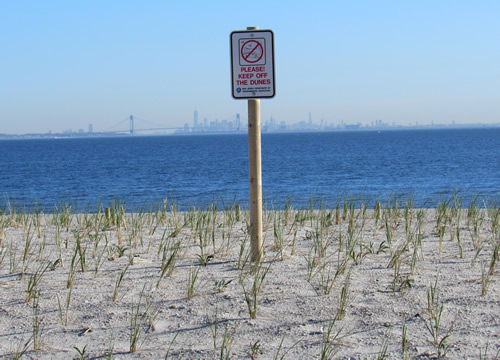
A nice new natural feature to observe at the Bayshore Waterfront Park are the emergent American dune grass or beach grass plants located on the high sandy dunes above the beach. This hardy grass was planted over the winter to help stabilize the newly replenished beach. The grass will help anchor shifting sands during harsh coastal wind storms and also create a welcoming place where other plants can grow more easily. These plants will help to naturally guard the coast against storm waves that could flood the land beyond the dunes. While the grass doesn’t look like much right now, it will spread horizontally quickly through rhizomes up to 6'-10' annually and will grow up to 2'-3' tall. While American dune grass is a tough pioneering plant that can tolerate very hot and salty environments, it cannot withstand people walking on it or much foot traffic, otherwise stems are broken and the plant dies. Please protect dune grass and its habitat by staying off the dunes and walking in designated areas to the beach only. (Posted 4/30/2015)
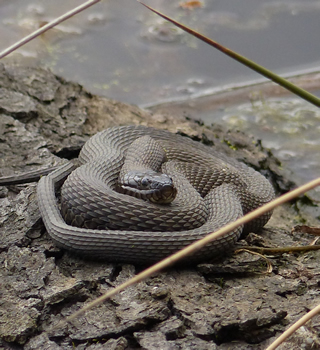
Our Roving Naturalist group happened upon this northern water snake during the Earth Day celebrations on Sunday. The northern water snake is a fairly common sight in the spring and summer near the lakes and waterways in our parks. They are often mistaken for the venomous cottonmouth water moccasin. The northern water snake does have a triangular shaped head, which is a trait often used to distinguish a venomous snake from a non-venomous one. The cottonmouth's northern range stops in Virginia and does not extend into Maryland, Delaware or New Jersey. There are no venomous snakes indigenous to Monmouth County. These are harmless snakes that will slither away into the water or beneath a rock when approached too closely.
The northern water snake can attain a length of about fifty-three inches. They are dark-colored snakes, brownish, tan or grayish in appearance. The back and sides have a series of square blotches alternating with each other that may merge to form bands. A dry adult snake will appear to be solid black or brown. The belly is white, yellowish or orangish and will have dark half-moon-shaped black edges. Females are usually much larger than the males. They may be found sunning themselves on rocks or logs and are very active in May and June. The northern water snake eats fish, amphibians, insects, birds, reptiles and small mammals. They are viviparous, which means they do not lay eggs and their young are born alive. (04/28/15)
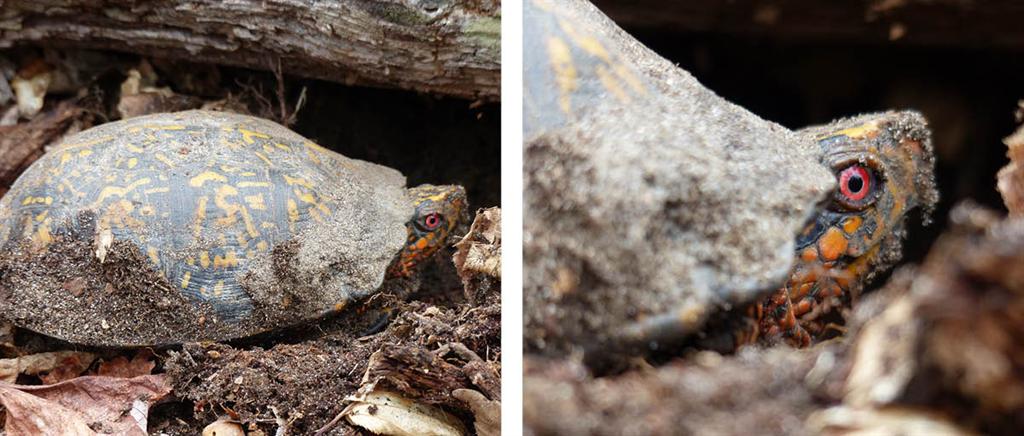
A Park System Naturalist recently discovered this eastern box turtle (Terrapene carolina carolina) apparently emerging from hibernation. Box turtles are cold blooded and therefore cannot regulate their body temperature. During the cold months of the year, eastern box turtles will look for a place to hibernate. This could be under a pile of leaves, under a log, in a log, or in an underground burrow vacated by another animal. Hibernation will generally start around September or October and last until temperatures start warming up in March or April. The function of the box turtles organs will slow down to a level that barely maintains life. In order for the box turtle to survive hibernation, it is essential that it be healthy prior to entering into this state. Hibernation plays an important role in the overall health and reproduction process. The eastern box turtle population is declining in New Jersey and it is listed as a "Species of Special Concern". The decline is largely due to loss of habitat. Many box turtles are also killed crossing roads and by lawn mowers. Box turtles are protected in New Jersey and it is illegal to take one out of the wild without a special permit. (4/24/15)
Spring is in the air and so are the calls of wood frogs, spring peepers, and New Jersey chorus frogs. These amphibians began calling in mid-March, but New Jersey chorus frogs may call as early as February. Wood frogs breed only in vernal wetlands; these temporary wetlands form from spring rains and snow and are vital for several amphibian species. Spring peepers also call from vernal wetlands, but are not particular and will use any body of freshwater to breed. The call of the wood frog is a duck-like quacking; tiny spring peepers, as their name implies, loudly peep; and the New Jersey chorus frogs have a 'preep’-like call. The eggs pictured above are wood frog eggs; the black dots are the embryos. They will hatch sometime in April and by June they will be adult frogs. (3/27/15)
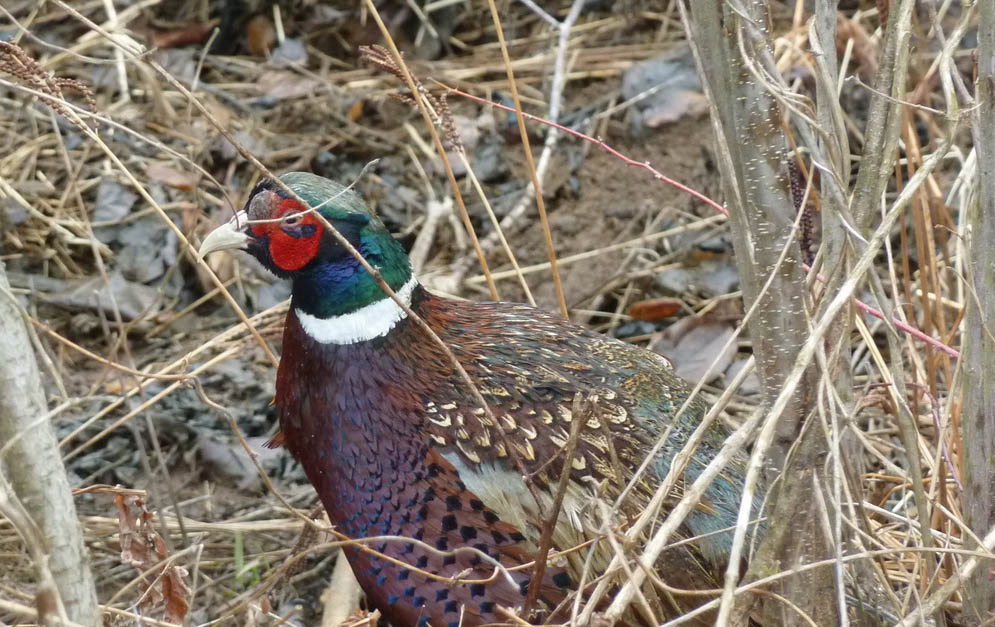
This beautiful bird was photographed by one of our Park System Construction Inspectors along the northern section of the Union Transportation Trail. The ringed-neck pheasant is one of the most popular game birds in the U.S. It is, however, not native to the state or even the continent. This is a Eurasian species that was introduced into the U.S. for hunting purposes back in the late 1800s. The U.S. population is made up of several subspecies. There are successful feral populations throughout much of the Midwest and northern sections of the country, but most populations need to be re-energized with newly released birds periodically. It remains a highly sought after game bird and is often released on private and public lands. This is a male bird or rooster. The female, or hen, is a mottled golden that will blend in well with the native plants. The ring-necked pheasant prefers open agricultural areas mixed with areas of vegetation. This chicken-like ground dwelling bird eats grain waste, insects and seeds. (3/26/15)
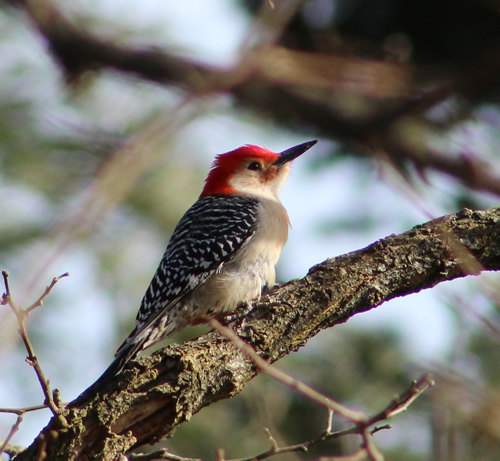
Red-bellied woodpecker
This red-bellied woodpecker was photographed along the Discovery Trail at Huber Woods Park. Easily identified by their strikingly barred black and white backs and vibrant red caps, the red-bellied woodpecker is a relatively common year-round resident of Monmouth County. Like other woodpeckers, the red-belly will work its way along the trunk or branches of a tree, picking at the bark to uncover insects and spiders hiding in bark crevices. The red-belly has a barbed tongue that extends nearly two inches past the edge of its beak and sticky saliva to help it to snatch prey from deep inside crevices. Occasionally, you may even witness one wedging a large nut into a crevice before using its beak to smash it into more manageably sized pieces. Keep an eye out for these sleek looking woodpeckers on the trunks and main branches of trees, as well as backyard bird feeders! (3/23/15)

Eagles' nest - photo by Dennis Ruffe
Hatching began later then previous years occurring March 2, possibly due to extremely cold weather conditions. This nest is the third in the state to have hatched so far. Reports are that many nests monitored throughout New Jersey are delayed. Typical indicators of hatching are changes in behavior such as an adult sitting higher in the nest and feeding the young. However, we will not have a chick count for at least three weeks. They need to grow enough to be seen above the nest edge; then we need to see all the heads up at the same time to get an accurate count. Eagles typically have between one to three chicks per season. Eaglets grow quickly, almost matching their parent’s size by six weeks. This requires a lot of food, especially fish, a favorite in their diet. This is another reason why the Manasquan Reservoir is great eagle habitat.
Please remember that nesting is an extremely sensitive time for eagles. A nest can fail with disturbance including people trying to get too close. Please do not approach the nest. (3/17/15)
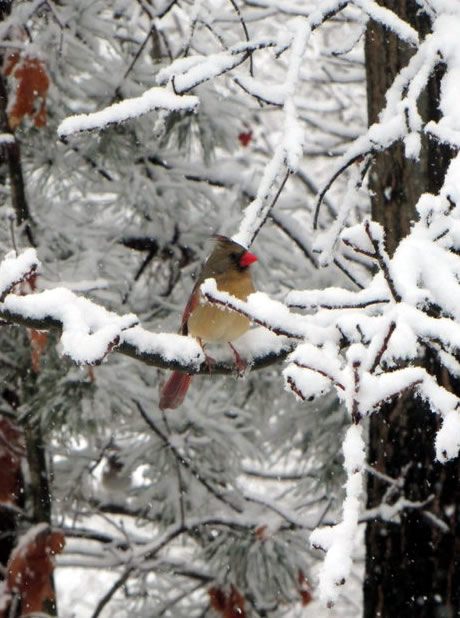
Female Northern Cardinal
Northern cardinals are always striking against a fresh winter snow. These birds are eye catching since they do not molt into a dull winter plumage as many other birds. Permanent residents throughout their range, northern cardinals do not migrate south. You can hear a cardinal singing daily even in the winter. Habitat preferences are dense shrubby areas, forested edges, overgrown fields and backyards. Berries and seeds are favorite foods from a wide variety of native plants, including various grasses, sedges and trees, such as mulberry, winged sumac, and hackberry. Insects are included on the menu and are especially important for nestlings. The range of the northern cardinal has been expanding further north and west; one explanation for this is the proliferation of backyard birdfeeders. (3/6/2015)

This red fox was spotted by Marlu Lake in Thompson Park.
There are two species of fox that occur in New Jersey; the red fox and the gray fox. The fox is a member of the Canine (dog) family. They can sometimes be difficult to tell apart as their coats can appear very similar. However, the white tipped tail of the red fox is always the key identifying character. There is some argument over the history of the red fox in New Jersey. Some maintain there was a small population of native red fox prior to the arrival of Europeans. Others believe it was introduced in the 1600’s. The Europeans liked to hunt fox for sport but when their dogs gave chase to the American gray fox it would run up a tree and hide instead of leading the hunters on merry chase through the woods. Thus, the Europeans introduced the European red fox and were able enjoy the sport in its traditional form. There are now healthy populations of both gray fox and red fox throughout our state. These animals have proven to be very adaptive and live in our towns and neighborhoods. The fox is mostly nocturnal and feeds primarily on small mammals, like meadow voles which make up about half of its diet. They are efficient scavengers and appreciate open garbage containers. They weigh about 8 to 15 pounds. Foxes are not a threat to humans but like all wild animals should be given a wide berth. Especially, if it may be acting strange or appear ill as the fox is a known rabies carrier. Posted: 03/05/15
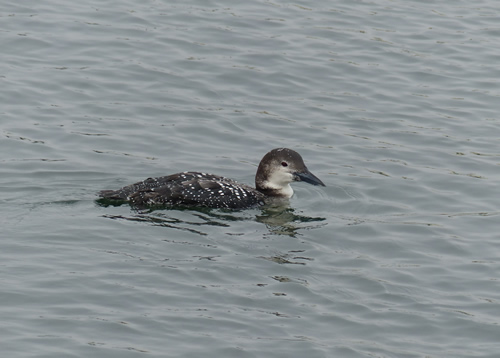
The Common Loon is actually very common along the New Jersey coastline during the winter months. Their winter plumage (exhibited on this bird) is not particularly striking. These large birds are very noticeable with a wingspan of 46”, length of 32”, weight of 9 lbs. It can fly in straight line at 70 mph. The Common Loon spends the summer months throughout all of Canada and south into the northern portions of Minnesota, Wisconsin, Michigan, New York, New Hampshire and Maine. Once extirpated from Massachusetts, there is currently a small re-introduced breeding population. Common Loons move inland during the breeding season and prefer quiet, crystal clear lakes to raise their young. They are known for an eerie forlorn sounding call. These birds are water birds and usually only come on shore to mate and to nest. The Common Loon needs about 30 yards of open water in order run and flap along the surface while it builds up enough speed to take off. Some loons have become stranded by landing in a parking lot, on a highway or in a small pond and are unable to reach take off speed. The Loon is an accomplished diver and extremely agile underwater. A study discovered that a family of four loons can eat about 1000 pounds of fish in a 15 week period. Posted: 03/02/15
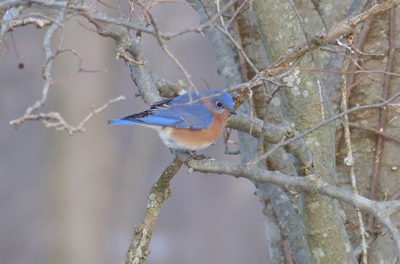
Eastern Bluebirds are a welcome sight in the spring and summer and some people may not associate them with the cold winter months. Eastern Bluebirds range from Manitoba Canada down to Nicaragua and have the largest range of the three Bluebirds found in North America. The Western Bluebird and the Mountain Bluebird have more restrictive ranges. New Jersey is on the northern most edge of the range where Eastern Bluebirds can be seen year round. These birds eat insects, berries and seeds. Some have been observed taking larger prey such as lizards, salamanders and shrews. Eastern Bluebirds maintain the same plumage colors throughout the winter and the male’s electric blue back and warm reddish brown breast is a beautiful sight against a winter backdrop. They are cavity nesters and will start searching for nesting sites in late February. Thompson Park, Dorbrook Park, Holmdel Park, Huber Woods and the Manasquan Reservoir are some of the parks which have Bluebird Nesting Boxes. Eastern Bluebirds will usually have at least two broods every year. This bird was photographed this week in Thompson Park and was hanging out with two other males and a female. Posted: 02/13/15
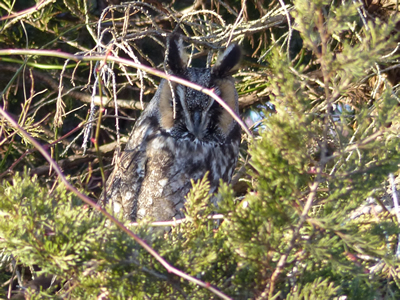
The Long-eared Owl was a former breeder throughout New Jersey from Sussex to Salem County. The clearing of forest for agriculture and general development during the late 1800’s and through the 1900’s reduced the number of breeding locations. The number of breeding pairs declined steadily through the 1960’s and 1970’s. There was an extensive search in the 1980’s but only a few nesting pair could be found. In 1991 the bird was listed as threatened in New Jersey and is now considered a rare winter visitor. Long-eared Owls are long lanky owls with two long tufts on top of their head. These owls are strictly nighttime feeders and fly low over open fields in search of mice, voles and other small mammals. They weigh just under a pound, have a wing span of about 39 inches and are about 16 inches long. They prefer to roost in evergreens such as spruce, pines, cedars, and hemlocks. The Long-eared Owls can arrive in NJ as early as November and are usually gone by the end of March. Several have been seen in our parks this year and this one was photographed this week by one of our Naturalists.
(posted 2/12/2015)
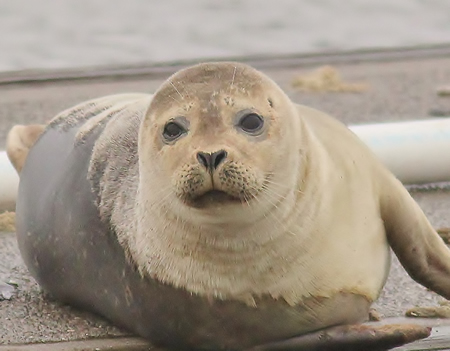
Harbor Seal
Recently, a Harbor Seal, a typical winter visitor to Sandy Hook Bay, was seen at the Bayshore Waterfront Park in Port Monmouth. A Park System Naturalist observed the seal early in the morning resting on a wooden dock most likely after a night of hunting or traveling. Harbor Seals frequently travel from northern New England or Canada to over-winter along the Jersey Shore. While here, seals will rest and feed on a wide variety of fish and crustaceans before swimming back north to mate in the spring. If you see a seal, please do not disturb the animal. Enjoy the sight from a distance. Harbor Seals and other marine mammals are protected by the federal Marine Mammal Protection Act. If you see a seal that appears injured, entangled, sick, or being harassed by a person, please call the Marine Mammal Stranding Center at 609-266-0538. This organization has the authority to help stranded or sick marine mammals and sea turtles. (Posted on 1/6/2015)
Back to Nature Now